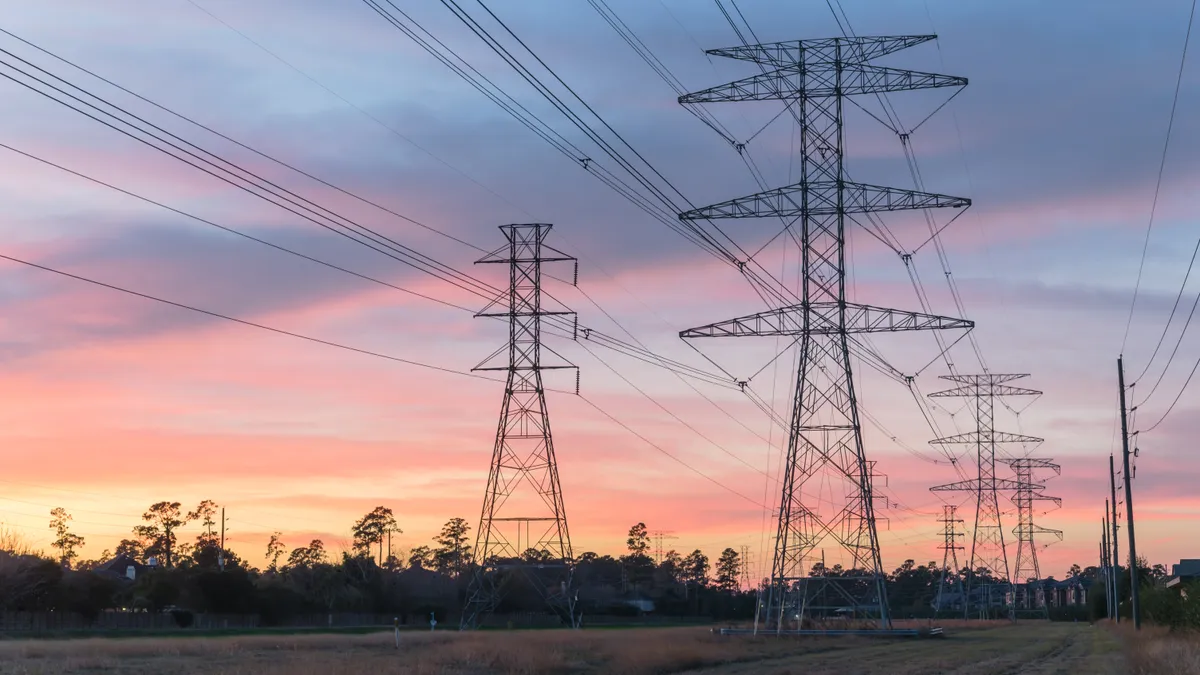Dive Brief:
- The Texas grid narrowly avoided blackouts Wednesday evening as cooling demand from extreme heat combined with thermal outages and low solar and wind output to force the state’s grid operator into emergency operating conditions.
- The Electric Reliability Council of Texas declared an Energy Emergency Alert 2 around 7:30 p.m. local time, allowing it to bring all available generation online, utilize reserve power and call on demand response. The EEA 2 was lifted after a little more than an hour.
- The extreme heat led to a new ERCOT September peak demand record of 82,705 MW. Last September, the highest demand recorded was 72,370 MW, the grid operator said.
Dive Insight:
ERCOT typically declares a less severe emergency, EEA 1, before turning to demand response and deploying operating reserves — but the situation moved so quickly Wednesday that the grid operator skipped that step.
“Due to low reserves and a drop in frequency, ERCOT entered directly into EEA 2. To protect the stability of the electric system, ERCOT has access to additional reserve sources only available during emergency conditions,” Pablo Vegas, ERCOT president and CEO, said in a statement.
An EEA 1 is called if operating reserves drop below 2,300 MW and are not expected to recover within 30 minutes. EEA 2 is called when operating reserves drop below 1,750 MW with similar recovery expectations. However, the grid operator indicated it was a drop in frequency that led to the EEA 2.
“High demand, lower wind generation, and the declining solar generation during sunset led to lower operating reserves on the grid and eventually contributed to lower frequency, which precipitated the emergency level 2 declaration,” Vegas said.
Grid frequency must be maintained between 60.1hz and 59.9hz, according to the grid operator.
Data from the ERCOT web site yesterday appeared to show frequency dropping to 59.8 hz, Texas energy analyst Alison Silverstein said in an email. She added that while wind output was low, it also appeared there was about 6,100 MW of thermal plants offline around 8 p.m. last night and ERCOT’s “general forecast for thermal outages anticipates 5 GW of thermal unavailable.”
That drop could be caused by a transmission line or power plant suddenly going out of service, Silverstein said. Battery resources kicked in between 7 p.m. and 8 p.m., she noted.
The EEA was likely triggered by a large power plant tripping offline, Texas energy market analyst and Stoic Energy President Doug Lewin tweeted. “Storage set an all-time record when it was needed most, almost certainly preventing rolling outages,” he added.
ERCOT posted an operational note after midnight, noting “no sudden loss of generation greater than 450 MW occurred” Wednesday.
“Thermal outages were not a factor in the ERCOT EEA last night. In fact, the thermal fleet performed extremely well, supplying more than 90% of the power Texans needed during that critical time,” Michele Richmond, executive director of Texas Competitive Power Advocates, said in an email.
Generators have been maintaining power plants, she said, taking small outages to make repairs or adjustments when anticipated demand was low or at times that other resources were expected to be available.
“This has been part of the effort to run as efficiently as possible and to be available to meet the record-breaking demand,” Richmond said. ERCOT has run the thermal fleet “exceptionally hard for an extended period of extreme heat to meet Texans’ needs. These resources will need to take time in the fall to perform required maintenance. … This means that tight conditions may occur in the fall if other resources on which ERCOT depends underperform.”
Utilities warned customers to conserve energy and brace for blackouts.
“If rotating outages are called, we anticipate these controlled outages will last for approximately 15 minutes,” CPS Energy, which serves the San Antonio area, told its customers. “These situations move very quickly, and we will give you as much notice as possible but expect a short window from notice to impact.”
Wednesday’s EEA 2 was the first time ERCOT has called a grid emergency since February 2021, according to Bloomberg. In that instance, frigid temperatures triggered blackouts that ultimately led to an overhaul of the state’s energy markets and the development of weatherization standards for energy assets.
The Texas grid has remained stable this summer despite the state experiencing several heat waves and higher demand from population growth and economic expansion.
Travis Kavulla, vice president of regulation for NRG Energy and a former Montana regulator, tweeted congratulations to ERCOT for its “nimble actions to tap all available reserves, imports, and demand response to prevent outages.” He added, “the big story here continues to be just the gobsmackingly huge growth in demand for electricity.”
Editor’s note: This story has been updated to include comments from the Texas Competitive Power Advocates and operational data from ERCOT.














